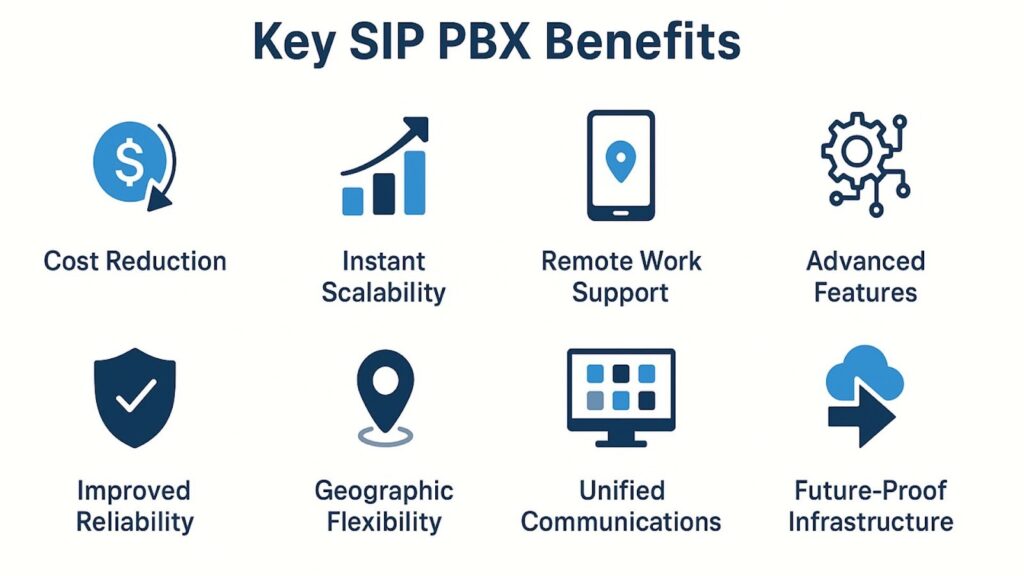
The Rise of SIP PBX: Why More Businesses Are Making the Switch
SIP PBX adoption is accelerating across multiple market studies, showing consistent double-digit growth.
Companies switching to SIP PBX gain immediate cost reductions while future-proofing their communications for distributed workforces.
Traditional PBX systems that served companies for decades are becoming obsolete, replaced by agile, internet-based alternatives that deliver superior functionality at a fraction of the cost. This simple change transforms how organizations connect, collaborate, and compete.
The global IP PBX market expanded to $33.63 billion in 2025, with projections showing continued growth to $74.62 billion by 2032. This remarkable 11.67% compound annual growth rate demonstrates that SIP PBX adoption has become essential for business survival.
What do the Numbers Say About SIP PBX Adoption Across Markets?
Market data reveals the growth driving SIP PBX adoption across industries. The transformation from traditional telephony to internet-based systems is a significant infrastructure shift in modern business history.
Multiple research firms confirm the trend’s acceleration. One analysis shows the market reaching $11.8 billion by 2032, growing at 7.4% CAGR, while other studies project even more aggressive expansion. This growth variation reflects the rapid pace of adoption across different business segments and geographic regions.
What’s Fueling This Growth?
The surge in SIP PBX adoption stems from fundamental changes in how businesses operate. Remote work has become a permanent operational strategy. Remote and hybrid work models are increasingly prevalent, creating communication requirements that legacy systems can’t meet.
Small and medium enterprises represent a rapidly growing segment of SIP PBX adoption, driven by subscription-based pricing models that make enterprise-grade features accessible without significant capital investments. These businesses are discovering that cloud-based PBX solutions offer enterprise-grade features without enterprise-level costs, granting access to advanced communication features that were previously reserved for large corporations.
Why Switch to SIP PBX?
The question facing business leaders is how quickly they can transition to modernize their communication systems. The business case for SIP PBX adoption encompasses operational efficiency, competitive advantage, and positioning for future growth.
Cost Savings That Transform Bottom Lines
Organizations consistently report dramatic cost reductions when switching from traditional PBX systems to SIP-based alternatives. Businesses can achieve 75% savings on communication expenses through the elimination of expensive PRI lines, reduced long-distance charges, and optimized channel utilization.
These savings compound over time as organizations leverage additional features without incurring traditional telecommunications markups. Unlike legacy systems that require costly upgrades for new functionality, SIP PBX platforms deliver enhanced features through software updates and cloud-based services.
Operational Flexibility That Drives Performance
Modern businesses require systems that adapt to changing operational demands. SIP PBX solutions provide instant scalability, allowing organizations to add or remove channels without hardware installations or service interruptions. This flexibility proves valuable for businesses with seasonal variations, project-based teams, or organizations experiencing rapid growth.

The ability to support distributed workforces without complex VPN configurations or expensive equipment deployments has become a competitive necessity. Employees can access full business phone systems from any location with internet connectivity, maintaining professional presence and communication consistency regardless of physical workspace.
PBX Transformation: From Legacy to Modern
Understanding the PBX transformation to SIP-based alternatives requires examining both the limitations of legacy infrastructure and the capabilities of modern solutions.
The Legacy Problem
Traditional PBX systems rely on physical hardware, dedicated phone lines, and complex wiring that create multiple operational challenges. These systems require high capital investment, ongoing maintenance contracts, and specialized technical expertise for modifications or expansions.
Legacy infrastructure also limits scalability and geographic flexibility. Adding phone lines requires physical installations, equipment upgrades, and coordination with multiple service providers. For businesses with multiple locations, this complexity multiplies exponentially, creating management overhead and operational inefficiencies.

The Modern Solution
SIP PBX systems transform communication infrastructure from physical assets to software-defined services. Voice, video, and data communications travel over existing internet connections, eliminating the need for separate telephone lines while providing superior functionality and reliability.
This architectural shift enables features impossible with traditional systems, such as advanced call analytics, artificial intelligence integration, seamless mobile connectivity, and real-time collaboration tools. Organizations gain access to enterprise-grade features through user-friendly interfaces that require minimal technical expertise to manage.
Which SIP PBX Benefits Are Driving Adoption?
Switching to SIP PBX benefits every aspect of business operations, from financial performance to employee productivity. These advantages explain why organizations across industries are accelerating their transition to internet-based communication systems.

1. Dramatic Cost Reduction
Monthly telecommunications expenses typically decrease through the elimination of traditional phone lines, reduced long-distance charges, and consolidated service providers. Organizations also avoid ongoing hardware maintenance contracts and upgrade costs.
2. Instant Scalability
Adding new users or locations requires only software configuration, not physical installations. Businesses can scale communication capacity up or down based on current needs without long-term commitments or infrastructure investments.
3. Enhanced Remote Work Support
Employees gain access to full business phone functionality from any internet-connected device. Features like call forwarding, voicemail-to-email, and presence indicators work seamlessly across home offices, mobile devices, and co-working spaces.
4. Advanced Feature Integration
SIP PBX platforms include auto-attendants, call queuing, conference calling, and CRM integration as standard features rather than expensive add-ons. Many providers also offer AI-powered analytics and fraud protection.
5. Improved Reliability
Cloud-based systems provide redundancy and failover capabilities superior to traditional PBX equipment. Calls can automatically route to mobile devices during internet outages, ensuring business continuity.
6. Geographic Flexibility
Organizations can establish phone numbers in any area code regardless of physical location, supporting market expansion without opening new offices. This capability benefits businesses serving multiple geographic markets.
7. Unified Communications
Integration of voice, video, messaging, and collaboration tools into a single platform improves productivity while reducing the complexity of managing multiple communication applications.
8. Future-Proof Infrastructure
SIP-based systems receive regular updates and new features through software deployments, ensuring communication capabilities evolve with business needs and technological advances.
Which Industries Are Leading the Charge?
Certain sectors are driving SIP PBX adoption at accelerated rates, demonstrating the technology’s versatility and business impact across diverse operational environments.
Small and Medium Enterprises
SMEs are a fast-growing segment of SIP PBX adoption. These organizations benefit from access to enterprise-grade features without the capital investments traditionally required for advanced communication systems. Subscription-based pricing models align costs with business growth, making sophisticated telephony accessible to companies at every stage of development.
Healthcare Organizations
Healthcare providers are implementing SIP PBX systems to support telemedicine initiatives, improve patient communication, and maintain HIPAA compliance. The ability to integrate with electronic health records and provide secure communications across multiple locations makes SIP technology valuable for medical practices and hospital systems.
Financial Services
Banks, insurance companies, and investment firms leverage SIP PBX capabilities for compliance recording, customer service optimization, and secure communications. Integration with CRM systems and call analytics provides insights that improve customer relationships while meeting regulatory requirements.
Technology Companies
IT and telecommunications organizations lead SIP PBX adoption due to their technical expertise and distributed workforce requirements. These companies often serve as early adopters, demonstrating advanced use cases that other industries subsequently implement.

What Should You Expect When Making the Switch?
Organizations considering SIP PBX implementation can expect a structured transition that minimizes disruption while maximizing benefits. Understanding the typical implementation timeline and requirements helps business leaders plan for modernization.
Assessment and Planning
Successful implementations begin with a comprehensive assessment of current communication requirements, future growth projections, and technical infrastructure capabilities. Choosing the right provider requires evaluating network quality, security features, customer support, and integration capabilities.
Technical Integration
Most modern business phone systems support SIP connectivity, allowing organizations to leverage existing equipment investments. For older systems, cost-effective analog telephone adapters provide compatibility without requiring complete equipment replacement.
Training and Adoption
User training focuses on new features and capabilities rather than basic operation, as most SIP PBX interfaces follow familiar communication patterns. Employee adoption typically proceeds smoothly due to improved functionality and user experience compared to legacy systems.
Ongoing Optimization
SIP PBX systems provide detailed analytics and reporting capabilities that enable continuous optimization. Organizations can identify usage patterns, optimize call routing, and implement features that improve productivity and customer service.
Frequently Asked Questions
What’s the difference between traditional PBX and SIP PBX systems? Traditional PBX relies on physical hardware and dedicated phone lines, while SIP PBX uses internet connections to deliver voice, video, and data communications through software-based systems. SIP offers superior scalability, lower costs, and advanced features impossible with legacy hardware.
How long does it take to implement SIP PBX for a typical business? Most SIP PBX implementations are completed within weeks, depending on system complexity and the number of users. Simple installations with existing compatible equipment can be operational within days, while larger deployments requiring integration with multiple locations may take several weeks.
Can we keep our existing phone numbers when switching to SIP PBX? Yes, number porting is standard with SIP PBX implementations. The process typically takes 5-15 business days, depending on the current carrier and number type. Most providers handle the porting process to minimize service disruption during the transition.
What internet bandwidth requirements are needed for SIP PBX? Each concurrent call requires approximately 85kbps of bandwidth for standard quality voice communications. Most modern business internet connections easily support multiple simultaneous calls, but providers can assess specific requirements based on expected usage patterns.
Is SIP PBX secure enough for sensitive business communications? Modern SIP PBX systems include enterprise-grade security features like end-to-end encryption, secure authentication protocols, and fraud protection. Many providers offer compliance certifications for regulated industries, including HIPAA, SOX, and PCI standards.
Building Tomorrow’s Communication Infrastructure
The rise of SIP PBX positions organizations for success in a distributed business environment. Companies that embrace this transition gain immediate operational and financial benefits while building communication infrastructure capable of adapting to future challenges and opportunities.
Market projections and adoption trends indicate that SIP PBX technology will become the standard for business communications within the next few years. Organizations that delay this transition risk competitive disadvantage as peers leverage advanced communication capabilities to improve customer service, employee productivity, and operational efficiency.
SIP.US provides enterprise-grade SIP PBX solutions designed for businesses of all sizes, with transparent pricing, reliable service, and comprehensive support. Get started today and discover how SIP technology can transform your organization’s communication capabilities.



